2018 Wildlife Archives: Incredible Findings and Photos
Welcome to the Kiawah Island Nature Program’s 2018 wildlife sightings page. Here, you’ll find postings from our Naturalists and island biologists showing you what is currently in the field as well as an archive of observations from throughout the year. We hope this site will get you excited about the amazing and diverse wildlife found on Kiawah. Get outside and share your photos and stories with us at Kiawah_Recreation@KiawahResort.com.
August 17, 2018 ~ Corn Snake (Pantherophis guttatus)
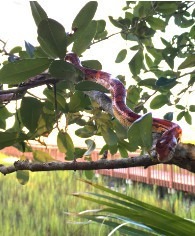 While setting up for a Tidal Trip & Dip kayaking excursion at Mingo Point, Naturalist Jake noticed that all of the birds by the nearby feeders were calling like crazy. After a closer inspection, a corn snake was spotted in one of the Live Oak branches in the tree! These non-venomous snakes are native to Kiawah and love to hunt for small birds, mice, and lizards. Thanks to the warning calls from the birds, Jake was able to spot this beautiful snake!
While setting up for a Tidal Trip & Dip kayaking excursion at Mingo Point, Naturalist Jake noticed that all of the birds by the nearby feeders were calling like crazy. After a closer inspection, a corn snake was spotted in one of the Live Oak branches in the tree! These non-venomous snakes are native to Kiawah and love to hunt for small birds, mice, and lizards. Thanks to the warning calls from the birds, Jake was able to spot this beautiful snake!
August 16, 2018 ~ Tiger Swallowtail (Papilio glaucus)
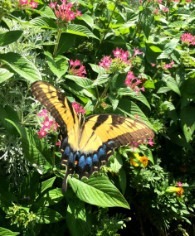 This Eastern Tiger Swallowtail was spotted in the gardens outside the Sanctuary by Naturalist Kristen. This is one of the numerous swallowtail species that we see on Kiawah during Summer and Fall. These next few months, we should start to see heavy butterfly flights as they migrate to their wintering grounds.
This Eastern Tiger Swallowtail was spotted in the gardens outside the Sanctuary by Naturalist Kristen. This is one of the numerous swallowtail species that we see on Kiawah during Summer and Fall. These next few months, we should start to see heavy butterfly flights as they migrate to their wintering grounds.
August 14, 2018 ~ Back Island Birding Species List
Highlights from this morning Back Island Birding tour with Naturalist Juliana Smith included a beautiful group of Black-bellied plovers, an insanely bright, golden yellow Prothonotary warbler, and a Yellow-crowned night heron juvenile who’s ALMOST an adult, we could see its adult colors growing in. Species List: Mourning Dove, Ruby-throated Hummingbird, American Oystercatcher, Black-bellied Plover, Whimbrel, Laughing Gull, Gull-billed Tern, Caspian Tern, Royal Tern, Wood Stork, Anhinga, Brown Pelican, Great Blue Heron, Great Egret, Tricolored Heron, Cattle Egret, Green Heron, Black-crowned Night-Heron, Yellow-crowned Night-Heron, Black Vulture, Mississippi Kite, Red-shouldered Hawk, Red-bellied Woodpecker, Downy Woodpecker, Pileated Woodpecker, Great Crested Flycatcher, Eastern Kingbird, Blue Jay, American Crow, Fish Crow, Tree Swallow, Barn Swallow, Carolina Chickadee, Tufted Titmouse, Marsh Wren, Carolina Wren, Blue-gray Gnatcatcher, Eastern Bluebird, Brown Thrasher, Northern Mockingbird, House Finch, Orchard Oriole, Red-winged Blackbird, Prothonotary Warbler, Pine Warbler, Northern Cardinal, Painted Bunting
August 11, 2018 ~ Spotted Eagle Ray (Aetobatus narinari)
Nick Reynolds, staff member at Kiawah Recreation, observed a Spotted Eagle Ray at Captain Sam’s Inlet.
August 9, 2018 ~ Back Island Birding Species List
Here’s our bird list from this morning’s Back Island Birding Tour with Naturalist Juliana Smith. Highlights were yellow-crowned night heron adults and juveniles, a beautiful yellow Prairie Warbler, and dozens of spoonbills and wood storks!
Today’s Species List: Wood Stork, Double-Crested Cormorant, Anhinga, Great Blue Heron, Great Egret, Snowy Egret, Tricolored Heron, Green Heron, Black-Crowned Night Heron, Yellow-Crowned Night Heron, Roseate Spoonbill, Black Vulture, Turkey Vulture, Osprey, Mississippi Kite, Red-Shouldered Hawk, Red-Tailed Hawk, Clapper Rail, Laughing Gull, Royal Tern, Mourning Dove, Red-Bellied Woodpecker, Downy Woodpecker, Great Crested Flycatcher, Eastern Kingbird, White-Eyed Vireo, Blue Jay, American Crow, Fish Crow, Barn Swallow, Carolina Chickadee, Tufted Titmouse, Marsh Wren, Carolina Wren, Blue-Gray Gnatcatcher, Eastern Bluebird, Brown Thrasher, Northern Mockingbird, Prairie Warbler, Eastern Towhee, Northern Cardinal, Blue Grosbeak, Painted Bunting, Red-Winged Blackbird, House Finch
August 7, 2018 ~ Back Island Birding Species List
This morning’s Back Island Birding Tour highlights were the warblers, Black-crowned Night Heron nests, and Mississippi Kite family. We watched as an adult Kite brought food to the juvenile, bringing it a cicada to munch on. We knew it was a cicada because we could hear it crying as it was passed from parent to kid. We saw families of night herons in various phases of life. Some parents with older kids, some with nestlings, and some completely independent juveniles. Finally, most exciting for me (other than watching the Kite family): We got three confirmed species of warblers and several others that were too quick for us to get good looks out. looks like Migration season should be starting soon and everyone’s in Prep Mode. Can’t wait to see what the Fall Migration season brings!
Today’s Species List: Wood Stork, Double-crested Cormorant, Anhinga, Great Egret, Snowy Egret, Tricolored Heron, Cattle Egret, Green Heron, Black-crowned Night Heron, Roseate Spoonbill, Black Vulture, Osprey, Mississippi Kite, Red-shouldered Hawk, Clapper Rail, Whimbrel, Laughing Gull, Royal Tern, Black Skimmer, Mourning Dove, Ruby-throated Hummingbird, Red-bellied Woodpecker, Great Crested Flycatcher, White-eyed Vireo, Blue Jay, Fish Crow, Barn Swallow, Carolina Chickadee, Marsh Wren, Carolina Wren, Eastern Bluebird, Brown Thrasher, Northern Mockingbird, American Redstart, Yellow Warbler, Prairie Warbler, Northern Cardinal, Blue Grosbeak, Painted Bunting, Orchard Oriole, Red-winged Blackbird, House Finch.
Happy birding from Naturalist Juliana Smith.
August 4, 2018 ~ Back Island Birding Species List
Naturalist Juliana Smith’s notes from her most recent Back Island Birding Tour: This morning was such a treat, even though it rained on us for a little bit. We saw feeding spoonbills and wood storks. A juvenile Seaside sparrow peeked at us through the marsh grasses. A Loggerhead shrike perched at the top of a tree, offering wonderful looks at the famed “Butcher Bird”. And a “daycare” of juvenile Yellow-crowned Night Herons amused us as they chased crabs through the marsh wrack line. PLUS a bonus rainbow, alligator, doe, and rabbit. Really a lovely morning!
Species list: Wild Turkey, Wood Stork, Brown Pelican, Great Egret, Snowy Egret, Little Blue Heron, Tricolored Heron, Cattle Egret, Green Heron, Yellow-crowned Night Heron, Roseate Spoonbill, Black Vulture, Osprey, Red-tailed Hawk, American Oystercatcher, Whimbrel, Willet, Laughing Gull, Forster’s Tern, Royal Tern, Black Skimmer, Mourning Dove, Red-bellied Woodpecker, Downy Woodpecker, Loggerhead Shrike, White-eyed Vireo, Blue Jay, Carolina Chickadee, Tufted Titmouse, Brown-headed Nuthatch, Marsh Wren, Carolina Wren, Blue-gray Gnatcatcher, Brown Thrasher, Northern Mockingbird, Pine Warbler, Yellow-throated Warbler, Seaside Sparrow, Northern Cardinal, Painted Bunting, Red-winged Blackbird, House Finch
August 3, 2018 ~ Manatee (Trichechus manatus)
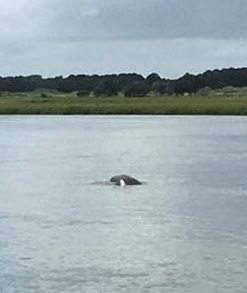 On Friday afternoon our Adventure Camp kids were out on the boat with our Naturalists when they saw this unfamiliar head pop up! It was a manatee, which isn’t common on our coast. Meredith Bean snapped this photo at Mingo Point!
On Friday afternoon our Adventure Camp kids were out on the boat with our Naturalists when they saw this unfamiliar head pop up! It was a manatee, which isn’t common on our coast. Meredith Bean snapped this photo at Mingo Point!
July 30, 2018 ~ Raccoon (Procyon lotor)
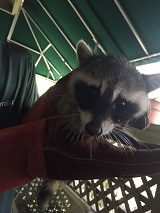 A common sight in urban environments, the raccoon (Procyon lotor) is a mammal some people aren’t too happy to see. The Kiawah Island Nature Center received a call from a home owner on July 24th about a possibly abandoned raccoon near her house. Raccoons are solitary animals but the kits stay with their mother for a couple of months before starting to venture out on their own.
A common sight in urban environments, the raccoon (Procyon lotor) is a mammal some people aren’t too happy to see. The Kiawah Island Nature Center received a call from a home owner on July 24th about a possibly abandoned raccoon near her house. Raccoons are solitary animals but the kits stay with their mother for a couple of months before starting to venture out on their own.
Unfortunately for this raccoon, the naturalists found no evidence that the mother was around and the young kit showed signs of dehydration and malnourishment. The raccoon did not fight back when picked up to be transported back to the Nature Center where the naturalists took a closer look at the animal. After pulling 5 ticks off the raccoon, the decision to transport him to a nearby wildlife rehab center was made and the raccoon was dropped off successfully.
As ubiquitous as they are with urban life, raccoons much prefer forests and woodlands near streams and bodies of water. They eat primarily small animals found in water such as crabs and snails but will readily scavenge for carrion, insects and plants. Raccoons are an important member of a healthy ecosystem due to their part as both predators for small animals and plants, but also as large prey items for larger carnivores.
Generally, if you leave wildlife alone it will leave you alone. Raccoons, like most other nocturnal mammals, are skittish and scared of humans due to our large size. As long as you keep your pets safe, teach your children not to feed the wild animals and do not corner a wild raccoon, you typically will be able to admire these beautiful animals from afar with no threat to anyone. In fact, there was a nesting family of raccoons in a tree in our Night Heron Park earlier in the summer! They were a welcome sight to our naturalists and proved to be model raccoons and showed no danger to anyone.
July 30, 2018 ~ Pipefish (Syngnathinae)
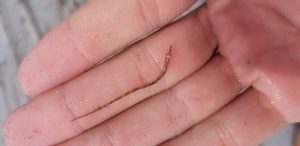 During an Ocean Seining program, Naturalist Travis Cherry and a guest pulled a seine net through the surf. Alongside the anchovies, speckled crabs and Florida pompano was a tiny pipefish (pictured here)!
During an Ocean Seining program, Naturalist Travis Cherry and a guest pulled a seine net through the surf. Alongside the anchovies, speckled crabs and Florida pompano was a tiny pipefish (pictured here)!
Capable of reaching 30 to 40 cm in length, pipefish are related to seahorses and seadragons, all making up the family Syngnathinae.
Pipefish are unique animals that exhibit the same reproductive qualities most people know about with seahorses: the males provide all the care for the developing young. After an elaborate courtship ritual, the female will insert her eggs into the male’s brood pouch or onto his brood patch where the male will fertilize the eggs and form a blood supply to the eggs. Male pipefish have been observed absorbing some eggs inside his patch. Why? Theories involve regaining some nutrients and energy from the eggs during times of stress, and choosing which eggs are more likely to be successful based on the mate they came from.
Most pipefish live in the coasts of tropical and temperate zones, and some pipefish can be found in freshwater. Because of their habitat, they are notably susceptible to industrial runoff and human development. Pipefish are also a species of possible concern due to their popularity in aquariums. There is currently not enough research done to conclusively determine the population of wild pipefish, but some states have regulations regarding their harvest and sale regardless. Pipefish are generally considered weak swimmers and can get caught in the surf as well. In nature, these fish are consuming mostly small crustaceans and mollusks.
July 24, 2018 ~ Back Island Birding Species List
Highlights from today’s Back Island Birding Tour with Naturalist Juliana Smith were male Blue Grosbeaks and Painted Bunting gleaming in the morning sun and the Ruby-throated Hummingbirds chasing any bird that dared get near their flower patch 🙂
Species List: Wood Stork, Double-crested Cormorant, Anhinga, Brown Pelican, Great Blue Heron, Great Egret, Snowy Egret, Tricolored Heron, Cattle Egret, Green Heron, White Ibis, Roseate Spoonbill, Black Vulture, Turkey Vulture, Osprey, Clapper Rail, Black-necked Stilt, Whimbrel, Willet, Lesser Yellowlegs, Laughing Gull, Least Tern, Royal Tern, Black Skimmer, Mourning Dove, Ruby-throated Hummingbird, Red-bellied Woodpecker, Pileated Woodpecker, Great Crested Flycatcher, White-eyed Vireo, Blue Jay, American Crow, Barn Swallow, Carolina Chickadee, Carolina Wren, Blue-gray Gnatcatcher, Eastern Bluebird, Brown Thrasher, Northern Mockingbird, European Starling, Northern Cardinal, Blue Grosbeak, Painted Bunting, Red-winged Blackbird, Brown-headed Cowbird, House Finch
July 18, 2018 ~ Back Island Birding Species List
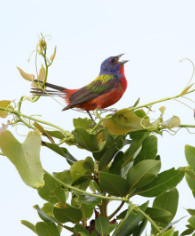
July 17, 2018 ~ Moon Snails (Neverita duplicata)
 Lee Boughton, Kiawah Island guest, discovered a slew of Moon Snails (aka Shark Eyes) while walking the beach this week. Moon Snails (Neverita duplicate) are native to our beaches and it seems Lee had stumbled upon a group of mating snails. In the photos she captured, you can see the females have pulled their bodies out and around their shells, forming a familiar ring shape. During the late summer, early fall, we will start to see the egg cases, called “sand collars,” these female snails are creating. To build her egg case, the female first extends her “foot” over her entire shell to collect sand. She will do this until her soft, sticky body is covered with sand granules. Then, she secretes mucas into the sand grains, which cements the sand together in a collar shape. Once she’s formed the collar, she’ll lay her eggs, then build a second layer of cement on top of her eggs. In the end, the eggs are sandwiched between two layers of mucas-sand cement. Thousands of eggs will be laid in each sand collar, which the female will leave buried in the sand. Once the larval moon snails hatch, the collar will disintegrate and the whole process will start again next season! Pretty neat! Thanks, Lee, for the photos!
Lee Boughton, Kiawah Island guest, discovered a slew of Moon Snails (aka Shark Eyes) while walking the beach this week. Moon Snails (Neverita duplicate) are native to our beaches and it seems Lee had stumbled upon a group of mating snails. In the photos she captured, you can see the females have pulled their bodies out and around their shells, forming a familiar ring shape. During the late summer, early fall, we will start to see the egg cases, called “sand collars,” these female snails are creating. To build her egg case, the female first extends her “foot” over her entire shell to collect sand. She will do this until her soft, sticky body is covered with sand granules. Then, she secretes mucas into the sand grains, which cements the sand together in a collar shape. Once she’s formed the collar, she’ll lay her eggs, then build a second layer of cement on top of her eggs. In the end, the eggs are sandwiched between two layers of mucas-sand cement. Thousands of eggs will be laid in each sand collar, which the female will leave buried in the sand. Once the larval moon snails hatch, the collar will disintegrate and the whole process will start again next season! Pretty neat! Thanks, Lee, for the photos!
July 15, 2018 ~ Bird Eggs
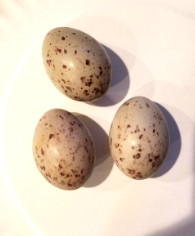 On Sunday, July 15th the Kiawah Island Nature Center received a call about a bird egg found by a guest on the beach. The guests took it to their home and a naturalist went by to learn more. Upon arrival and inspection of the egg, it turned out to be an egg from one of our nesting shorebirds!
On Sunday, July 15th the Kiawah Island Nature Center received a call about a bird egg found by a guest on the beach. The guests took it to their home and a naturalist went by to learn more. Upon arrival and inspection of the egg, it turned out to be an egg from one of our nesting shorebirds!
Kiawah Island is home to a large variety of nesting shorebirds ranging from the minute Least Tern weighing in at an average of 30-45 grams to the comparatively giant Brown Pelican at an average 3500 grams.
Birds are fantastic parents, able to provide the egg with the perfect amount of care. If an egg is too hot, a bird might stop incubation or in the case of some of our shorebirds, they dip down into the water to wet their feathers to cool the egg and some even shade it using their wings. Others will pluck downy feathers from around their brood patch and use that to shade the eggs as well. Most birds will also rotate their eggs in the nest so that the entire egg is incubated evenly. Some studies suggest this is also to prevent the membrane from getting stuck to the inside of the shell.
However great our avian caretakers are, sometimes nature has other plans. Recently we had an unusually high tide coupled with a few storms. This lead to some nests being destroyed or otherwise disturbed. Some of these eggs were washed up on our beaches to be found by guests of the island.
If you ever find an egg on the beach, please leave it alone! Nature has provided the best animal for the job. Removing the egg could prevent the parent from finding the egg to continue caring for it and potentially kill the chick. You might also be plucking a perfectly viable egg from a nest! Not all nests are created equally and some of our shorebirds just scrape a small depression in the sand with little to no additions.
July 12, 2018
July 12: This just in! The first Loggerhead sea turtle nests have hatched on Kiawah! We received a report this morning that three nests hatched last night!
July 11, 2018 ~ Century Plant (Agave americana)
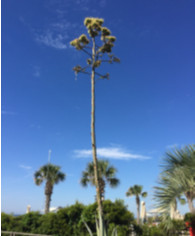 A blooming century plant is found beside the beach showers along the Sanctuary Hotel boardwalk. A staggering 20-30 feet in height, this succulent thrives in areas of little moisture. The Agave americana is monocarpic, which means the mature plant will die after flowering. Nutrients are stored within the plant and once ready to flower, a chemical change will trigger the process. All of the plants energy will then go into gaining height and creating the greenish yellow flowers. These plants usually bloom anywhere between 10 – 30 years!is found beside the beach showers along the Sanctuary Hotel boardwalk. A staggering 20-30 feet in height, this succulent thrives in areas of little moisture. The Agave americana is monocarpic, which means the mature plant will die after flowering. Nutrients are stored within the plant and once ready to flower, a chemical change will trigger the process. All of the plants energy will then go into gaining height and creating the greenish yellow flowers. These plants usually bloom anywhere between 10 – 30 years!
A blooming century plant is found beside the beach showers along the Sanctuary Hotel boardwalk. A staggering 20-30 feet in height, this succulent thrives in areas of little moisture. The Agave americana is monocarpic, which means the mature plant will die after flowering. Nutrients are stored within the plant and once ready to flower, a chemical change will trigger the process. All of the plants energy will then go into gaining height and creating the greenish yellow flowers. These plants usually bloom anywhere between 10 – 30 years!is found beside the beach showers along the Sanctuary Hotel boardwalk. A staggering 20-30 feet in height, this succulent thrives in areas of little moisture. The Agave americana is monocarpic, which means the mature plant will die after flowering. Nutrients are stored within the plant and once ready to flower, a chemical change will trigger the process. All of the plants energy will then go into gaining height and creating the greenish yellow flowers. These plants usually bloom anywhere between 10 – 30 years!
July 10, 2018 ~ Back Island Birding Species List
Species list from this morning’s Back Island Birding Tour with Naturalist Juliana Smith. A huge highlight of their trip was watching the Cooper’s Hawk hopping amongst the Red-winged Blackbird nests and eventually finding success, flying away with a chick in its talons. Species List: Wood Stork, Double-crested Cormorant, Anhinga, Brown Pelican, Great Blue Heron, Great Egret, Little Blue Heron, Tricolored Heron, Reddish Egret, Cattle Egret, Green Heron, Roseate Spoonbill, Black Vulture, Osprey, Mississippi Kite, Cooper’s Hawk, Red-shouldered Hawk, Clapper Rail, Black-necked Stilt, American Oystercatcher, Laughing Gull, Least Tern, Gull-billed Tern, Forster’s Tern, Royal Tern, Black Skimmer, Mourning Dove, Ruby-throated Hummingbird, Red-bellied Woodpecker, Great Crested Flycatcher, White-eyed Vireo, Blue Jay, American Crow, Fish Crow, Carolina Chickadee, Brown-headed Nuthatch, Marsh Wren, Carolina Wren, Blue-gray Gnatcatcher, Eastern Bluebird, Brown Thrasher, Northern Mockingbird, Northern Cardinal, Blue Grosbeak, Painted Bunting, Red-winged Blackbird, Brown-headed Cowbird, Boat-tailed Grackle, House Finch
July 5, 2018 ~ Back Island Birding Species List
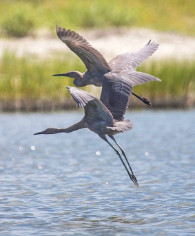 Species list from this morning’s Back Island Birding Tour with Naturalist Juliana Smith! The highlights for this morning were definitely the bright yellow, female Orchard Orioles we encountered in the agricultural fields 🙂 And as per usual, the Roseate Spoonbills and Reddish Egrets never cease to please! Species list: Wood Stork, Anhinga, Brown Pelican, Great Egret, Snowy Egret, Little Blue Heron, Tricolored Heron, Reddish Egret, Cattle Egret, Green Heron, Roseate Spoonbill, Black Vulture, Osprey, Mississippi Kite, Red-shouldered Hawk, Clapper Rail, American Oystercatcher, Semipalmated Plover, Willet, Lesser Yellowlegs, Laughing Gull, Royal Tern, Black Skimmer, Mourning Dove, Ruby-throated Hummingbird, Red-bellied Woodpecker, Downy Woodpecker, Pileated Woodpecker, Great Crested Flycatcher, White-eyed Vireo, Fish Crow, Barn Swallow, Carolina Chickadee, Tufted Titmouse, Carolina Wren, Blue-gray Gnatcatcher, Eastern Bluebird, Brown Thrasher, Northern Mockingbird, European Starling, Northern Cardinal, Painted Bunting, Orchard Oriole, Red-winged Blackbird, Boat-tailed Grackle, House Finch. Young photographer, Adam Wolf, joined us on our Back Island Birding. For more images, check out his instagram: awolfphotoman
Species list from this morning’s Back Island Birding Tour with Naturalist Juliana Smith! The highlights for this morning were definitely the bright yellow, female Orchard Orioles we encountered in the agricultural fields 🙂 And as per usual, the Roseate Spoonbills and Reddish Egrets never cease to please! Species list: Wood Stork, Anhinga, Brown Pelican, Great Egret, Snowy Egret, Little Blue Heron, Tricolored Heron, Reddish Egret, Cattle Egret, Green Heron, Roseate Spoonbill, Black Vulture, Osprey, Mississippi Kite, Red-shouldered Hawk, Clapper Rail, American Oystercatcher, Semipalmated Plover, Willet, Lesser Yellowlegs, Laughing Gull, Royal Tern, Black Skimmer, Mourning Dove, Ruby-throated Hummingbird, Red-bellied Woodpecker, Downy Woodpecker, Pileated Woodpecker, Great Crested Flycatcher, White-eyed Vireo, Fish Crow, Barn Swallow, Carolina Chickadee, Tufted Titmouse, Carolina Wren, Blue-gray Gnatcatcher, Eastern Bluebird, Brown Thrasher, Northern Mockingbird, European Starling, Northern Cardinal, Painted Bunting, Orchard Oriole, Red-winged Blackbird, Boat-tailed Grackle, House Finch. Young photographer, Adam Wolf, joined us on our Back Island Birding. For more images, check out his instagram: awolfphotoman
June 22, 2018 ~ Eastern Diamondback Rattlesnake (Crotalus adamanteus)
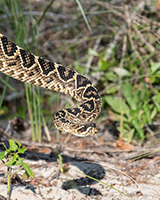
This snake was released by naturalist Jake Zadik in a remote location where it hopefully will not come into conflict with people again. Jake noted the snake was very calm mannered, slowly slithered in the opposite direction from the release site, and only rattled when Jake took a step in its direction.
June 21, 2018 ~ Eastern Screech Owl (Megascops asio)
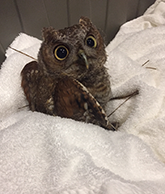 Around noon on Sunday, June 17th, Naturalists Meriwether and Travis responded to an owl rescue call. An Eastern Screech Owl was found in the road on Governor’s Drive. This newly fledged bird appeared stunned and could have potentially fallen from the nest or tree. We were able to move the screech owl so that it could rest for a few hours in a calm, dark space to wear the shock off. The best course of action was to then bring the owl back to the site where it was found. Once the box was opened, the owl flew out immediately into a wooded area. Thank you to our guests who called to ensure the owls safety!
Around noon on Sunday, June 17th, Naturalists Meriwether and Travis responded to an owl rescue call. An Eastern Screech Owl was found in the road on Governor’s Drive. This newly fledged bird appeared stunned and could have potentially fallen from the nest or tree. We were able to move the screech owl so that it could rest for a few hours in a calm, dark space to wear the shock off. The best course of action was to then bring the owl back to the site where it was found. Once the box was opened, the owl flew out immediately into a wooded area. Thank you to our guests who called to ensure the owls safety!
June 20, 2018 ~ Nesting Hardships on Deveaux
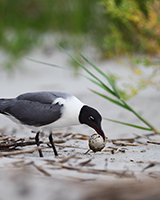
Though land predators are mostly nonexistent on the island, parents still have to keep a close eye on their nests. The birding group noted a number of Laughing gulls pestering the nesting parents attempting to get an easy meal. This is a photo of a successful laughing gull consuming an American Oystercatcher egg.
June 12, 2018 ~ Loggerhead Sea Turtle (Caretta caretta)
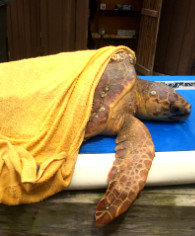 While on a stand-up paddleboard tour today, Naturalist and Nature Program Manager, Kristen Lococo spotted what looked like a plastic bag floating in the Kiawah River. It turned out to be a Loggerhead Sea Turtle with a pretty severe boat strike. With help from Naturalist Jake Zadik and the Dungan family, we were able to transport the turtle back to Mingo where we met SCDNR to take it to the South Carolina Sea Turtle Hospital. A good reminder for all of our boaters; keep a sharp lookout for wildlife and keep your distance. We hope to update you with good news!
While on a stand-up paddleboard tour today, Naturalist and Nature Program Manager, Kristen Lococo spotted what looked like a plastic bag floating in the Kiawah River. It turned out to be a Loggerhead Sea Turtle with a pretty severe boat strike. With help from Naturalist Jake Zadik and the Dungan family, we were able to transport the turtle back to Mingo where we met SCDNR to take it to the South Carolina Sea Turtle Hospital. A good reminder for all of our boaters; keep a sharp lookout for wildlife and keep your distance. We hope to update you with good news!
June 12, 2018 ~ Back Island Birding Species List
Species list from this morning’s Back Island Birding Tour with Naturalist Juliana Smith: Wild Turkey , Wood Stork, Double-crested Cormorant, Anhinga, Brown Pelican, Least Bittern, Great Blue Heron, Great Egret, Snowy Egret, Little Blue Heron, Tricolored Heron, Reddish Egret, Cattle Egret, Green Heron, White Ibis, Glossy Ibis, Roseate Spoonbill, Osprey, Mississippi Kite, Clapper Rail, Common Gallinule, Black-necked Stilt, American Oystercatcher, Greater Yellowlegs, Willet, Laughing Gull, Least Tern, Gull-billed Tern, Royal Tern, Black Skimmer, Mourning Dove, Red-bellied Woodpecker, Pileated Woodpecker, Blue Jay, American Crow, Fish Crow, Barn Swallow, Carolina Chickadee, Tufted Titmouse, Blue-gray Gnatcatcher, Northern Mockingbird, European Starling, Pine Warbler, Northern Cardinal, Painted Bunting, Red-winged Blackbird, Brown-headed Cowbird, Boat-tailed Grackle, House Finch
June 6, 2018 ~ Deuxbank Birding Excursion
 Deveaux Bank Birding was out-of-this-world! We arrived on the bank around 7 pm and were immediately met by an Osprey chowing down on her dinner within close range. As we scanned the horizon using the scope, we saw numerous shore birds and wading birds delivering food to fledglings, finding their own dinners, and collecting for their nightly roost. Marbled godwits, American Oystercatchers, Black Skimmers, Black-bellied Plovers, Gull-billed Terns, Semipalmated plovers and sanderlings, Wood storks, Roseate spoonbills, Little Blue Herons, Snowy Egrets, Willets, Least Terns, Glossy Ibis, and hundreds of Brown Pelicans were actively preparing for night. We were surprised when they suddenly all took off into the air, but the appearance of a Bald eagle explained the impromptu theatrics. Even the dining Osprey took flight, but returned as soon as the eagle was out of sight and resumed her meal. In addition to birds, we found stunning shells and the most gargantuan ghost crabs ever! The entire tour plus our ride back to Andell bluff as the sun was setting reminded this naturalist why she’s lucky to be living in this truly spectacular place. Here’s looking forward to our next boat ride out to Deveaux bank! Hope to see you there!
Deveaux Bank Birding was out-of-this-world! We arrived on the bank around 7 pm and were immediately met by an Osprey chowing down on her dinner within close range. As we scanned the horizon using the scope, we saw numerous shore birds and wading birds delivering food to fledglings, finding their own dinners, and collecting for their nightly roost. Marbled godwits, American Oystercatchers, Black Skimmers, Black-bellied Plovers, Gull-billed Terns, Semipalmated plovers and sanderlings, Wood storks, Roseate spoonbills, Little Blue Herons, Snowy Egrets, Willets, Least Terns, Glossy Ibis, and hundreds of Brown Pelicans were actively preparing for night. We were surprised when they suddenly all took off into the air, but the appearance of a Bald eagle explained the impromptu theatrics. Even the dining Osprey took flight, but returned as soon as the eagle was out of sight and resumed her meal. In addition to birds, we found stunning shells and the most gargantuan ghost crabs ever! The entire tour plus our ride back to Andell bluff as the sun was setting reminded this naturalist why she’s lucky to be living in this truly spectacular place. Here’s looking forward to our next boat ride out to Deveaux bank! Hope to see you there!
Naturalist Juliana Smith
June 6, 2018 ~ Stories Captured on Wildlife Photography Tour
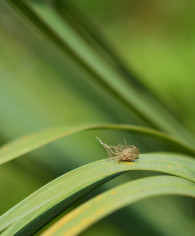 The small ‘hair ball’ looking structure at the center of this photo is not a hair ball at all. Rather it is the larva of a Palmetto Tortoise Beetle (Hemisphaerota cyanea). These young beetles have a unique defense against potential predators. They will hold on to their feces after expelling it creating this swirling ‘hair-ball’ like structure above them. It keeps them pretty well hidden and has been proven to deter predators– who would want to sift through feces to get to their meal?
The small ‘hair ball’ looking structure at the center of this photo is not a hair ball at all. Rather it is the larva of a Palmetto Tortoise Beetle (Hemisphaerota cyanea). These young beetles have a unique defense against potential predators. They will hold on to their feces after expelling it creating this swirling ‘hair-ball’ like structure above them. It keeps them pretty well hidden and has been proven to deter predators– who would want to sift through feces to get to their meal?
This photo was taken by Naturalist Jake Zadik on our first Wildlife Photography Tour of the season! We photographed a ton of beautiful wildlife such as herons, egrets, painted buntings, alligators, and tree frogs. However, in photography, sometimes its the little things that make the best stories– like this poop covered larva. Click to see more photos taken on this tour.
June 2, 2018 ~ Honey Bees
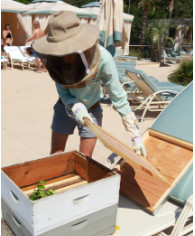 On Saturday, May 26, employees at The Loggerhead Bar & Grill on the pool deck of The Sanctuary Hotel noticed a “swarm” or cluster of bees in one of the shrubs leading out towards their adult pool. Upon notifying the Nature Program, it was clear to see that they were in fact honeybees. But what was all the buzz about? They were stripping the fresh wax off of the shrub that had just bloomed and were using it to create themselves a hive. There seemed to be roughly one hundred honeybees all working hard in unison, nicely packed together, which indicated their queen was also present.
On Saturday, May 26, employees at The Loggerhead Bar & Grill on the pool deck of The Sanctuary Hotel noticed a “swarm” or cluster of bees in one of the shrubs leading out towards their adult pool. Upon notifying the Nature Program, it was clear to see that they were in fact honeybees. But what was all the buzz about? They were stripping the fresh wax off of the shrub that had just bloomed and were using it to create themselves a hive. There seemed to be roughly one hundred honeybees all working hard in unison, nicely packed together, which indicated their queen was also present.
Our trusty local beekeeper, Captain Mike Albenesius, often referred to as “Salty Mike,” was called and he responded right away. He believed these bees were remnants of a larger hive that he removed the week prior. Without hesitation, Mike clipped the entire branch that the bees were building on and removed it just before daybreak to ensure the bees were still sleeping calmly. This would also remove any pheromone, or scent, left on that particular branch in case any bees were left behind in the process.
The very next day, more bees were present! It was truly puzzling to see about twenty or so new honeybees re-building on that same shrub- they just decided to pick a different branch this time. Mike had a genius idea that would ensure a safe and effective removal but also benefit the bees. He brought in a wooden hive box and set it on a lounge chair directly in front of the shrub that was drawing all the attention. Mike clipped the new branch and laid it next to the old one inside the box. The bees instantly began to shift their attention from the branch to the frames of wax that were in there. By the end of the day, they were building onto those frames and settling into their new home quite nicely. It was so neat seeing them enter and exit the hive through the front entrance, as if they had lived there forever.
Mike successfully removed the hive box after two full days at the pool. That gave enough time to capture the highest number of bees in that colony and let them get acclimated to their new living quarters. During those few days, the staff at Loggerhead was so excited, fascinated, and willing to help the bees while also ensuring that all guests were kept safe during the process. The entire area was safely roped off from where the bees first nestled into the shrub to the perimeter of the wooden hive box. The Loggerhead manager even created a sign to further educate our guests about the bees. There was definitely excitement and curiosity in the air from guests and staff- really a unique experience for all!
We would like to personally thank Mike for his time and effort he put forth in this project. We truly couldn’t have saved them all without his generous support and selflessness. He brought a fun and educational awareness to Kiawah that we are so thankful for. We would also like to thank The Sanctuary Hotel and all staff at Loggerhead Bar & Grill for being so willing to accommodate our new pollinator friends. As a team, we all made it our mission to “Save the Bees” one honeybee at a time. Mission accomplished! The entire colony is now working tirelessly and happily in their new hive box at Mike’s house and we couldn’t ‘BEE’ happier.
Brittaney Callahan, Kiawah Island Golf Resort Recreation and Bee Keeper
May 31, 2018 ~ Back Island Birding Species List
Today’s species list from Back Island Birding with Naturalist Juliana Smith: Wood Stork, Double-crested Cormorant, Anhinga, Brown Pelican, Least Bittern, Great Egret, Snowy Egret, Little Blue Heron, Tricolored Heron, Reddish Egret, Green Heron, White Ibis, Glossy Ibis, Osprey, Clapper Rail, Common Gallinule, Black-necked Stilt, Laughing Gull, Gull-billed Tern, Caspian Tern, Forster’s Tern, Royal Tern, Red-bellied Woodpecker, Downy Woodpecker, Pileated Woodpecker, Great Crested Flycatcher, Blue Jay, American Crow, Fish Crow, Barn Swallow, Carolina Wren, Blue-gray Gnatcatcher, Eastern Bluebird, Northern Mockingbird, Pine Warbler, Yellow-throated Warbler, Eastern Towhee, Northern Cardinal, Painted Bunting, Red-winged Blackbird, Boat-tailed Grackle, House Finch
May 30, 2018 ~ Loggerhead Sea Turtle (Caretta caretta)
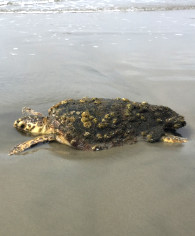 Another Loggerhead Sea Turtle washed up on our beach. Thank you to the guests who reported it to the Nature Center. Through a coordinated effort between Kiawah Town Biologists and SC Department of Natural Resources, the turtle was transported to the SC Aquarium Sea Turtle Hospital for evaluation.
Another Loggerhead Sea Turtle washed up on our beach. Thank you to the guests who reported it to the Nature Center. Through a coordinated effort between Kiawah Town Biologists and SC Department of Natural Resources, the turtle was transported to the SC Aquarium Sea Turtle Hospital for evaluation.
May 27, 2018 ~ Anhinga (Anhinga anhinga)
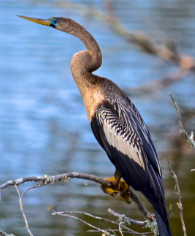
May 24, 2018 ~ Raccoon (Procyon lotor)
 When walking around Kiawah be observant. You can easily walk past some very cool critters without even realizing it. Today, while leading a school group naturalist Evan spotted a mother raccoon and her babies. Baby coons are called cubs or kits and this family was found in a hole in one of Night Heron Park’s live oak trees. Raccoons are most often born in early summer and will stay in the den (the hole in our live oak) for the first two months. After this time, the cubs/kits will venture out for entire nights at a time without their mother. If you see any of them wandering by themselves, don’t worry! They’re just exploring and will find their way back to mom. Our cubs/kits will become completely independent by the time they are 8-12 months old. Be sure to make your way to Night Heron Park to see if you can spot them!
When walking around Kiawah be observant. You can easily walk past some very cool critters without even realizing it. Today, while leading a school group naturalist Evan spotted a mother raccoon and her babies. Baby coons are called cubs or kits and this family was found in a hole in one of Night Heron Park’s live oak trees. Raccoons are most often born in early summer and will stay in the den (the hole in our live oak) for the first two months. After this time, the cubs/kits will venture out for entire nights at a time without their mother. If you see any of them wandering by themselves, don’t worry! They’re just exploring and will find their way back to mom. Our cubs/kits will become completely independent by the time they are 8-12 months old. Be sure to make your way to Night Heron Park to see if you can spot them!
May 23, 2018 ~ Atlantic Bottlenose Dolphin (Tursiops truncatus)
 Lowcountry Marine Mammal Network has identified a new dolphin calf at Captain Sam’s Inlet.
Lowcountry Marine Mammal Network has identified a new dolphin calf at Captain Sam’s Inlet.
May 23, 2018 ~ Loggerhead Sea Turtle (Caretta caretta)
 When I dismounted from my bike on the Sanctuary Beach, a small crowd had already formed around a shallow pool left by the receding tide. Kiawah Turtle Patrol was already there, with their bright green shirts, and we were waiting for SC Department of Natural Resources (DNR) to arrive.
When I dismounted from my bike on the Sanctuary Beach, a small crowd had already formed around a shallow pool left by the receding tide. Kiawah Turtle Patrol was already there, with their bright green shirts, and we were waiting for SC Department of Natural Resources (DNR) to arrive.
A guest of the resort had been on the beach earlier that morning, when he saw the Loggerhead sea turtle bobbing its head up above the water. It wasn’t clear how long it had been there, because it wasn’t clearly visible when underwater and had been missed by anybody else walking along the beach that morning. The guest notified the Sanctuary Hotel, who called Turtle Patrol and DNR.
From what we could see, part of the turtle’s front left flipper was missing. One of the Kiawah Turtle Patrol members guessed that it might be from a shark bite or something similar. They also noted that the turtle wasn’t diving, and guessed that it might be due to air pockets under its shell, known as “Bubble Butt syndrome.” After a few minutes of waiting, DNR arrived to transport the turtle from where it was stranded to the Sea Turtle Hospital at the South Carolina Aquarium.
The DNR representative, along with two Turtle Patrol helpers, pulled out a yellow stretcher, which has flat “arms” which can be wrapped around the turtle to secure it. As they lifted the turtle to place it into the stretcher, which floated on the surface of the water, they realized that the turtle was being held down by a fishing line, which was wrapped around its flipper. One of the beach employees supplied a knife, and the line was cut away. In shock, they realized that the line was wrapped around a second Loggerhead sea turtle. We were sad to learn that this second turtle was already deceased. Upon closer inspection, there were many different lines attached to it. One was what we typically think of as fishing line, thin and transparent, which was wrapped around its neck and front flipper. Another was also thin, but a dark color, and was wrapped around its front and back flippers, stretched over the stomach. The line which had attached the two turtles was a thicker rope line.
Fishing can be a great danger to sea turtles. They can be tangled in nets and drowned, or they can swallow hooks after being attracted to the bait. Although most of this danger comes from commercial fisheries, Turtle Patrol told us that the fishing line found on this turtle could have come from either a commercial or recreational fisher. Fishing line isn’t the only man-made object in the ocean threatening sea turtles, either. Every year we throw thousands of pounds of trash into the ocean, and by 2050, scientists expect there to be more plastics than fish in the ocean, by weight.
Today’s rescue reminds us that it’s important to do everything we can to keep our wildlife safe. Making sure that the seafood we buy from the grocery store was caught by turtle-friendly fisheries, eating local seafood when we go to restaurants (the Southeast has some of the strictest fishing regulations in the world!), and following the three R’s of reduce, reuse, and recycle are just a few things that we can do to help our sea turtle population. Starting Memorial Day, the South Carolina Aquarium is joining the In Our Hands Plastic Challenge, which is a campaign across American aquariums which seek to reduce single-use plastics in their facilities and to encourage their patrons to do the same.
Luckily, the litter in our ocean did not spell the end of our first turtle’s life. Thanks to the guest who noticed the turtle bobbing its head, and who notified the resort right away, DNR was able to transport it to the Sea Turtle Hospital here in Charleston, where it will be rehabilitated and hopefully find a long life ahead of it.
Molly Collins ~ Kiawah Island Golf Resort Recreation
May 22, 2018 ~ Roseate Spoonbill (Platalea ajaja)
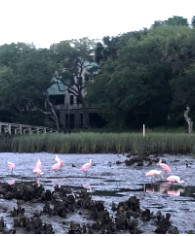
May 22, 2018 ~ Kemp’s Ridley Sea Turtle (Lepidochelys kempii)
Five miles offshore, while on our Near Coastal and Reef Fishing Charter, Captain John Ward spotted a Kemp’s Ridley Sea Turtle in distress. Suffering from a buoyancy disorder, the turtle could not dive, making it extremely vulnerable to predators and motorboats. Captain Ward brought the turtle on-board, and transported it to Mingo Point. Upon his arrival, he was met by SC Department of Natural Resources. The turtle is currently undergoing treatment at the Sea Turtle Hospital. We hope to keep you updated with good news.
May 17, 2018 ~ Back Island Birding Species List
Species list from today’s Back Island Birding Tour with Naturalist Juliana Smith: Red-breasted Merganser, Wild Turkey, Double-crested Cormorant, Anhinga, Brown Pelican, Least Bittern, Great Blue Heron, Great Egret, Snowy Egret, Little Blue Heron, Tricolored Heron, Cattle Egret, Green Heron, Glossy Ibis, Black Vulture, Turkey Vulture, Osprey, Common Gallinule, Black-necked Stilt, American Oystercatcher, Black-bellied Plover, Semipalmated Plover, Piping Plover, Ruddy Turnstone, Dunlin, Semipalmated Sandpiper, Spotted Sandpiper, Willet, Lesser Yellowlegs, Laughing Gull, Ring-billed Gull, Least Tern, Gull-billed Tern, Forster’s Tern, Royal Tern, Sandwich Tern, Mourning Dove, Chimney Swift, Red-bellied Woodpecker, Downy Woodpecker, Great Crested Flycatcher, White-eyed Vireo, Blue Jay, Fish Crow, Northern Rough-winged Swallow, Barn Swallow, Carolina Wren, Blue-gray Gnatcatcher Eastern Bluebird, Brown Thrasher, Northern Mockingbird, European Starling, Northern Parula, Eastern Towhee, Summer Tanager, Northern Cardinal, Painted Bunting, Red-winged Blackbird, Brown-headed Cowbird, Boat-tailed Grackle, House Finch. 61 total species!
May 11, 2018 ~ Red-headed Woodpecker (Melanerpes erythrocephalus)
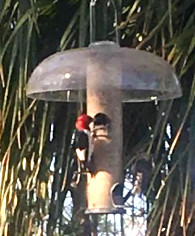 Red-headed woodpecker spotted at Mingo Point by Naturalist Jake Zadik!
Red-headed woodpecker spotted at Mingo Point by Naturalist Jake Zadik!
May 9, 2018 ~ Brittle Star (Class Ophiuroidea)
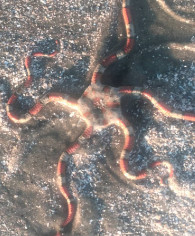 Brittle Sea Stars are echinoderms, like starfish, and as such share many characteristics with their distant cousins. Sea stars however, have longer and thinner arms than starfish and they are considered more mobile, moving along the sea floor searching for food. With over 2000 species of brittle stars, they are considered one of the most specious of echinoderms. Their name ‘brittle stars’ refers to their defense mechanism of detaching one of their arms to escape or distract predators. Luckily, most brittle stars can regenerate the arm provided the break is before the central disk. A very rare find for Kiawah, this brittle star was found on our Night Beach Walk with Naturalist Ryan Donnelly.
Brittle Sea Stars are echinoderms, like starfish, and as such share many characteristics with their distant cousins. Sea stars however, have longer and thinner arms than starfish and they are considered more mobile, moving along the sea floor searching for food. With over 2000 species of brittle stars, they are considered one of the most specious of echinoderms. Their name ‘brittle stars’ refers to their defense mechanism of detaching one of their arms to escape or distract predators. Luckily, most brittle stars can regenerate the arm provided the break is before the central disk. A very rare find for Kiawah, this brittle star was found on our Night Beach Walk with Naturalist Ryan Donnelly.
May 9, 2018 ~ Loggerhead Sea Turtle (Caretta caretta)
Kiawah’s first Loggerhead Sea Turtle nest of the season!
May 7, 2018 ~ Leatherback Sea Turtle (Dermochelys coriacea)
First Naturalist sighting of the season! Naturalist Meredith Bean spotted a Leatherback Sea Turtle while on her Shelling Excursion in the North Edisto River.
May 3, 2018 ~ Sea Onion (Paranthus rapiformis)
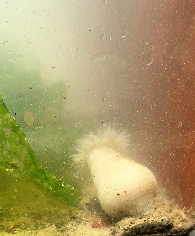 This Sea Onion was captured by Naturalists Meredith and Ryan while pulling a seine net through the water on the front beach for a school group. Sea onions are a type of anemone that will ball up like an onion when it is washed out of its burrow. These anemones will burrow around 14 inches below the sand and elongate their bodies to extend their tentacles at the surface. Onion anemones will prey on small invertebrates but are also supplemented with food by symbiotic algae, or zooxanthellae, that live within its tentacles.
This Sea Onion was captured by Naturalists Meredith and Ryan while pulling a seine net through the water on the front beach for a school group. Sea onions are a type of anemone that will ball up like an onion when it is washed out of its burrow. These anemones will burrow around 14 inches below the sand and elongate their bodies to extend their tentacles at the surface. Onion anemones will prey on small invertebrates but are also supplemented with food by symbiotic algae, or zooxanthellae, that live within its tentacles.
April 26, 2018 ~ Sharks
Water in the marsh is warming up. Our Captains are reporting the first sharks of the season.
April 21, 2018 ~ Piping Plover (Charadrius melodus)
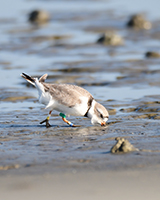
The shore birds on Kiawah’s beach are migrating north for the summer. They are visiting the beach to rest and eat. They need to reenergize before they continue their trip. Please give these shore birds respect and observer them from a distance. Chasing shorebirds will cause them to waste energy that they would otherwise use for their migration.
April 19, 2018 ~ Green Treefrog (Hyla cinerea)
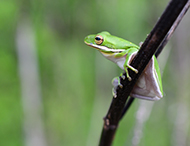
April 3, 2018 ~ Painted Bunting (Passerina ciris)
First sighting of the season…. Painted Bunting at Mingo Point!
March 24, 2018 ~ American Alligator (Alligator mississippiensis)
On today’s Gator Walk, Naturalist James Wilson, spotted gator B019 in the pond between Maritime Villas and the Roy Barth Tennis Center (pond 039). B019 is a tag that was placed on this alligator as part of a research project. B019 is a 7.9 foot male who was tagged on July 10, 2017 in this same pond.
March 17, 2018 ~ American Alligator (Alligator mississippiensis)
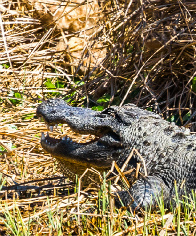 Alligators don’t sweat like us humans do. One way they cool down is to open their mouth in a process called gaping. Gaping is when alligators lay ashore with their mouths open for prolonged periods of time. This is a thermoregulatory response that reduces the alligator’s head temperature.
Alligators don’t sweat like us humans do. One way they cool down is to open their mouth in a process called gaping. Gaping is when alligators lay ashore with their mouths open for prolonged periods of time. This is a thermoregulatory response that reduces the alligator’s head temperature.
March 4, 2018 ~ Common Goldeneye (Bucephala clangula)
 It was an exciting week for our Nature Program. Wonderful spring wildlife sightings all across the island. We witness a fantastic community effort to return a fledgling eagle to its nest (February 27 Facebook post), documented a Common Goldeneye (March 2 Facebook post), welcomed new Naturalists to our team, and 2 Naturalist interns from St. Johns High. Finally, as though Mother Nature was summarizing our week’s adventures, the very last hour of work provided a wonderful wrap up.
It was an exciting week for our Nature Program. Wonderful spring wildlife sightings all across the island. We witness a fantastic community effort to return a fledgling eagle to its nest (February 27 Facebook post), documented a Common Goldeneye (March 2 Facebook post), welcomed new Naturalists to our team, and 2 Naturalist interns from St. Johns High. Finally, as though Mother Nature was summarizing our week’s adventures, the very last hour of work provided a wonderful wrap up.
At Turtle Point, we tried to capture our own photo of our rare Common Goldeneye. Quietly waiting, hoping he would swim within distance of the lens, we sat on the bank of the pond. After some period of time and not much luck with our photo, we took our eyes off the goldeneye to see if there were any other photo ops. To our amazement, directly in front of us was a magnificent Bald Eagle feasting on a bird. Given our proximately to our Night Heron Park nest, we were confident this was one our parents. And as though posing for our camera he sat in that tree providing graphic shots of the circle of life.
As we left the island for the night, both Bald Eagle parents were at the nest, a sign we took that all was safe on the island tonight.
February 28, 2018 ~ American Alligator (Alligator mississippiensis)
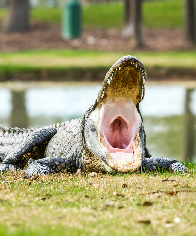 Have you ever seen an alligator yawn? Yes, alligators yawn just like we do. This yawn provides us with a unique look into the gator’s mouth. Look closely at the top of the throat you will see a small opening; this is the beginning of the esophagus, which leads to the stomach.
Have you ever seen an alligator yawn? Yes, alligators yawn just like we do. This yawn provides us with a unique look into the gator’s mouth. Look closely at the top of the throat you will see a small opening; this is the beginning of the esophagus, which leads to the stomach.
When a gator submerges, water can easily enter into the mouth. But alligators have a special flap (palatal valve) near the back of the tongue that seals the throat, preventing water from getting into the esophagus and trachea. This feature allows an alligator to open its mouth underwater without flooding its throat, which is especially important when feeding on aquatic prey.
At Turtle Point, we tried to capture our own photo of our rare Common Goldeneye. Quietly waiting, hoping he would swim within distance of the lens, we sat on the bank of the pond. After some period of time and not much luck with our photo, we took our eyes off the goldeneye to see if there were any other photo ops. To our amazement, directly in front of us was a magnificent Bald Eagle feasting on a bird. Given our proximately to our Night Heron Park nest, we were confident this was one our parents. And as though posing for our camera he sat in that tree providing graphic shots of the circle of life.
As we left the island for the night, both Bald Eagle parents were at the nest, a sign we took that all was safe on the island tonight.
February 26, 2018 ~ Bald Eagle (Haliaeetus leucocephalus)
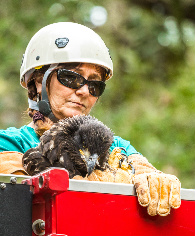 On the morning of February 19th a gentleman walked into our Nature Center at Night Heron Park to inform us that there was an injured Golden Eagle on our bike path. Our Naturalists knew immediately that our resident Bald Eagle must have fledged the nest. Resort Naturalists arrived on site to find a healthy, stoic juvenile Bald Eagle sitting on the ground (Feb 19th facebook post).
On the morning of February 19th a gentleman walked into our Nature Center at Night Heron Park to inform us that there was an injured Golden Eagle on our bike path. Our Naturalists knew immediately that our resident Bald Eagle must have fledged the nest. Resort Naturalists arrived on site to find a healthy, stoic juvenile Bald Eagle sitting on the ground (Feb 19th facebook post).
Bald Eagles begin to leave the nest (fledge) at about 10-14 weeks. Prior to that first flight, nestlings will flap their wings in the nest. They will also jump to nearby branches, a behavior known as branching. Ending up on the ground during this time is not necessarily a cause for alarm.
However, after 48 hours on the ground in a high traffic area, we became concerned. When our Town Biologist, Aaron Given, consulted with both US Fish and Wildlife and the South Carolina Center for Birds of Prey, it was determined that taking the bird in for an examination was the best course of action. Birds of Prey determined that besides a high parasite load, the bird was healthy and just perhaps too young to be out of the nest. They provided treatment for the round worms and rehydrated the bird, with the plans of re-nesting it.
Today with a large scale community effort between St. John’s Fire District, Center for Birds of Prey, Town of Kiawah Island, SC Biologists and Kiawah Island Community Association, the idea was to put the juvenile eagle back into the nest. Decked with hard hats for protection from the parents, Debbie from the Center for Birds of Prey (with the eagle in her arms!) and 2 members of St Johns Fire and Rescue were hoisted 80 feet into the air. At first, onlookers were concerned as no parents were visible. But as the bucket of the ladder truck got within feet of the nest, one of the parents came into view. Alas, our goose bump moment, as it began flying wide circles in the area just as the fledgling was successfully placed into the nest.
As we left the island for the night, both Bald Eagle parents were at the nest, a sign we took that all was safe on the island tonight.
February 19, 2018 ~ Bald Eagle (Haliaeetus leucocephalus)
 This morning a gentleman walked into our Nature Center at Night Heron Park to inform us that there was an injured Golden Eagle on our bike path. Our Naturalists knew immediately that our resident Bald Eagle must have fledged the nest. Resort Naturalists arrived on site to find a healthy, stoic juvenile Bald Eagle sitting on the ground.
This morning a gentleman walked into our Nature Center at Night Heron Park to inform us that there was an injured Golden Eagle on our bike path. Our Naturalists knew immediately that our resident Bald Eagle must have fledged the nest. Resort Naturalists arrived on site to find a healthy, stoic juvenile Bald Eagle sitting on the ground.
Kiawah has several Bald Eagle nests and it is time for the juveniles to fledge. Fledging is when a bird is ready to leave the nest and learn to fly. Consequently, this time of the year finding juvenile Bald Eagles on or near the ground is normal. You may think the bird has been abandoned, but the adults are probably watching and waiting for you to leave. If you find a fledgling maintain your distance and only watch for a few minutes. If you are concerned call the Heron Park Nature Center, 843.768.6001 or our Town Biologists, 843.768.9166.